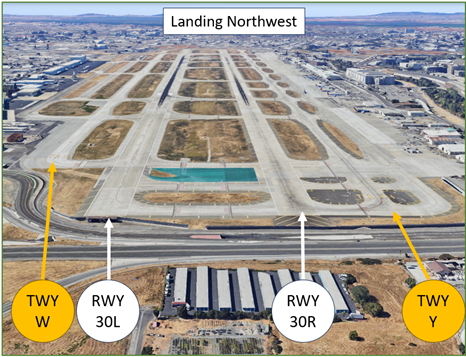Norman Y. Mineta San Jose International Airport (SJC)
Norman Y Mineta San Jose International Airport (SJC) is a medium sized, multi-use airport located in the city of San Jose, California. While predominantly an air carrier airport, there is a sizable general and corporate aviation presence at the field. The airport is divided with air carrier facilities on the east side and general and corporate aviation on the west side of the runways. Transient parking is located at either of the two FBOs located on the west side of the airport. The west side taxiway system is complex and there are several parallel taxiways plus connectors that provide access into and out of transient parking. View a printable Pilot Handbook of the SJC information found on this Web page.
Know Before You Go
SJC TWR Hours of Operation-0600L-0000L 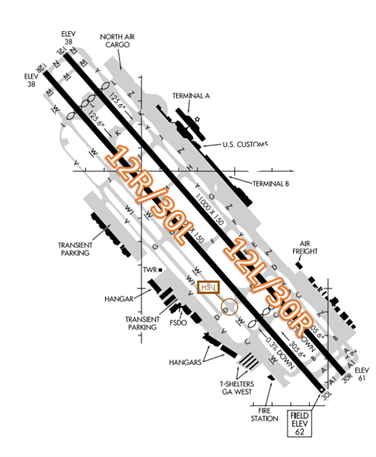
Admin Office Open 0800L to 1630L M-F
Business Phone 408-982-0750
The airport configuration consists of closely spaced parallel RWY’s 12L/30R and 12R/30L.
The airspace at SJC is Class C and underlies San Francisco’s Class B airspace. (Refer to Sectional Chart)

Below find various SJC-specific information and things to be aware of, as well as general information to inform your preflight planning. This will be reviewed quarterly and updated as needed. This information is to supplement the From the Flight Deck Videos that are produced by the FAA Runway Safety Group. Here you will also find information provided by the local air traffic controllers at the airport where you intend to fly. The information is subject to change. Not for navigation or legal* pre-flight action. Always refer to official pre-flight materials such as, but not limited to, NOTAMs, airport diagrams, VFR charts and airport construction notices for the latest airport-specific details.
Hot Spots
- HS 1: RWY Incursion risk. RWY 30L at TWY D. Short Distance from run-up area to RWY.
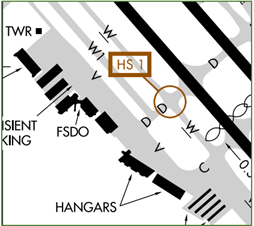
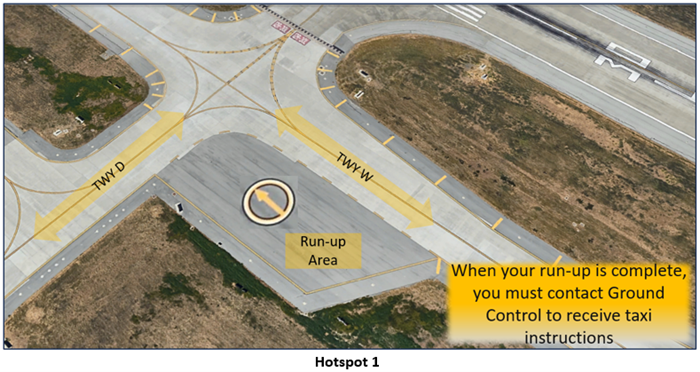
- Prior to exiting the ramp, pilots requiring a run-up should make the request with Ground Control (GC). GC will instruct the aircraft to taxi to the Run-up Area at the intersection of TWY W and TWY D.
- Pilots that have completed the run-up sometimes attempt to taxi directly from the Run-up Area to RWY 30L at TWY D without receiving taxi clearance from GC.
- This is in a non-movement area and pilots must contact GC to receive taxi instructions prior to exiting the Run-up Area.
- Taking into consideration wake turbulence requirements, GC will issue taxi instructions to the assigned departure RWY.
- NOTE: The arrow painted on the surface of the run-up area indicates the direction that aircraft should face when performing a run-up.
Wrong Surface Risk
- Closely spaced parallel RWYs with full length parallel TWYs increase the risk of wrong surface landings.
- At SJC, pilots sometimes confuse RWY 30L with RWY 30R and RWY 12L with RWY 12R. Pilots may also confuse a parallel TWY for a RWY.
- Positive identification of the RWY should be a part of every pilot’s checklist.
- If available, back up all visual approaches with an instrument approach to help ensure that you are lined up for the correct surface.
- Runway Markings are white. Markings on surfaces not used for takeoff/landing like Taxiway Markings, Chevrons, RWY Shoulder and RWY Turn-on Markings etc., are yellow.
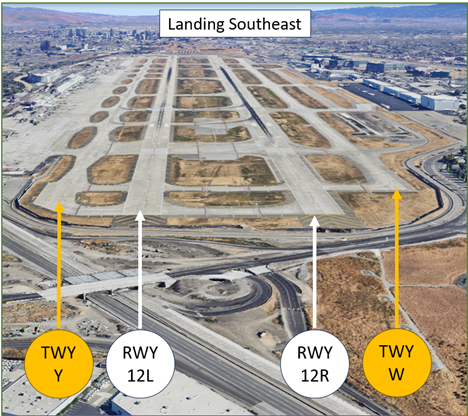
Wrong Airport Landing Risk
- Reid-Hillview (RHV) of Santa Clara County, is a small, primarily general aviation airport located on the southeast side of the city of San Jose, California.
- It is approximately five miles southeast of the larger SJC, with a similar RWY configuration.
- These two airports are so close that they are often mistaken for one another, even with the considerable difference in size.
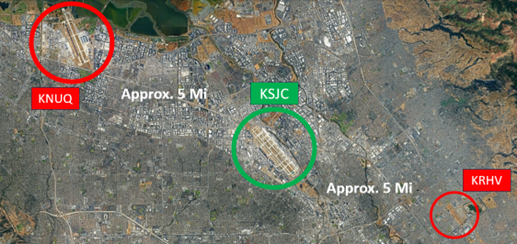
- Approximately six miles northwest of SJC is Moffett Federal Airfield (NUQ).
- The runway configurations are similar enough that pilots inbound to SJC from the north and west have misidentified NUQ and have attempted to land there.
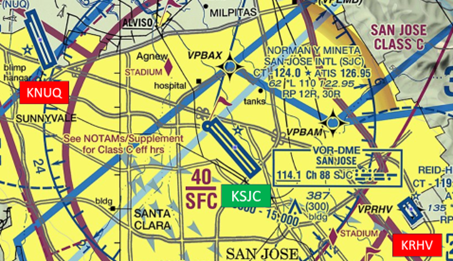
- During pre-flight planning, check the sectional chart for airports in close proximity and charted reporting points.
- Use the most precise navigational aids available such as GPS, localizers, or VOR radials to positively identify the airport.
- If you're talking to ATC and you're unsure, ask the controller.
- View the From the Flight Deck-Wrong Airport Landings video for more information and mitigation strategies.
Surface Risk – Movement Area Cautions
- Pilots exiting the RWY sometimes don’t fully clear the RWY Hold Short Line.
- When exiting the RWY, taxi without delay to cross the hold short line for the RWY behind you. Your aircraft is not clear until it is completely across this line.
- A delay in completely exiting the RWY can cause aircraft landing behind you to go around.

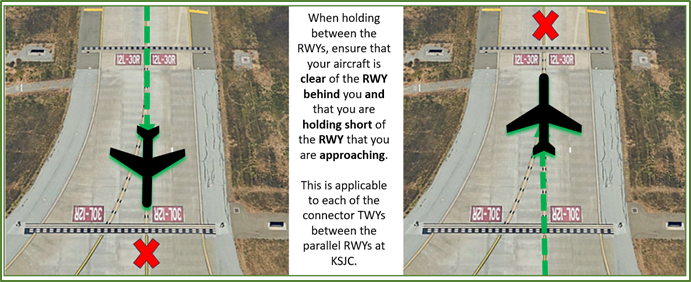
Additional Cautions
- As an additional measure to assist pilots with positive identification of the RWYs, SJC has the word “TAXI” painted on TWY W and TWY Y at the approach ends of RWYs 12L/R and 30L/R.

- RWYs 12L/R and 30L/R have displaced thresholds.
- The portion of RWY behind a displaced threshold is available for takeoffs in either direction or landings from the opposite direction.
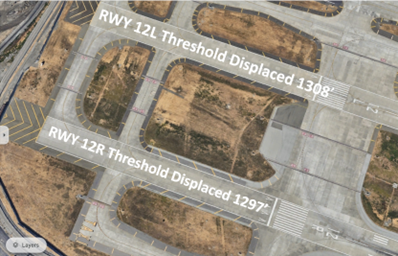
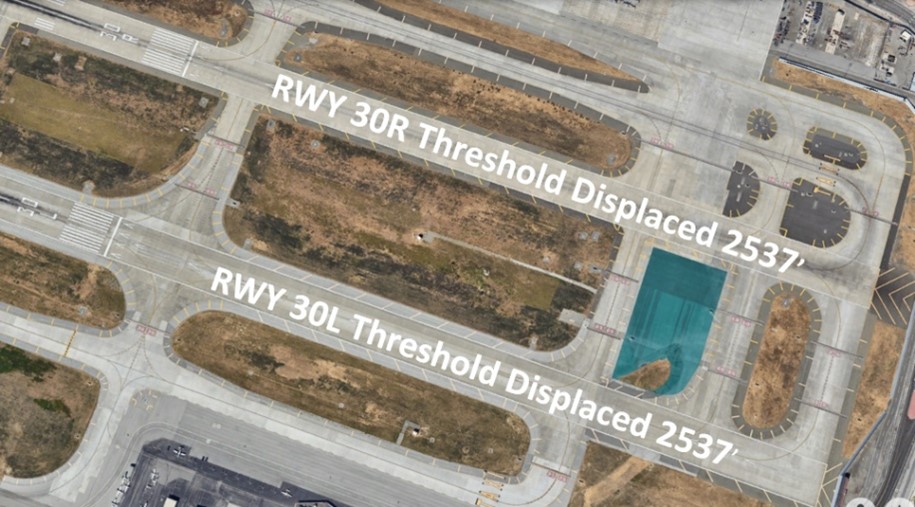
Traffic Patterns
- SJC has closely set parallel RWYs and TWR will occasionally instruct pilots to fly right traffic to the left RWY or left traffic to the right RWY.
- Actively listen, and when in doubt on your RWY assignment, don’t hesitate to ask the controller.
Ground Control
- Non-turbine pilots requesting an intersection departure should advise Ground Control (GC) on initial contact.
- Aircraft staged for intersection departures may incur some additional wait time due to wake turbulence requirements.
- Pilots should refrain from conducting run-ups at the exit to GA-West as it is the only exit from the parking area.
- Pilots should also be aware that there is a vehicle service road that goes around the perimeter of the airfield.
- There may appear to be areas for run-up in these locations, but there are none. Aircraft are prohibited from conducting run-ups in this area.
- If a run-up is needed, pilots should make the request with GC and taxi instructions to the Run-up Area will be issued by the controller. (See Hot Spot 1)
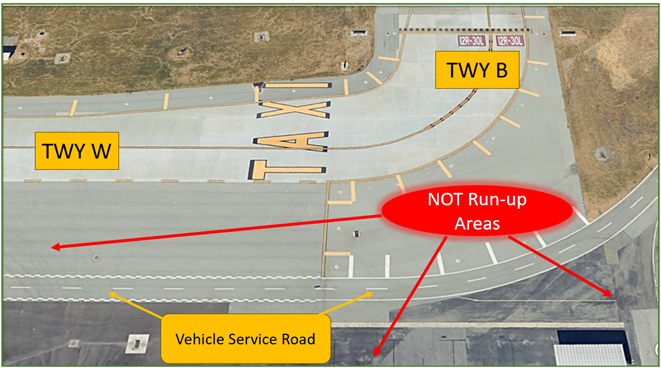
VFR Overflights
- Controllers will often instruct pilots, transitioning SJC airspace, to cross SJC midfield at an altitude usually at or above 1500’ AGL.
- It is important that pilots cross at midfield which is over the control tower. Crossing closer to the departure end will conflict with departing aircraft.
- It is also important that pilot’s cross perpendicular to the RWYs for separation purposes.
Arrival/Landing
- GA parking is primarily on the southwest side of the airfield.
- GA pilots that land on RWY 12L/30R will exit and hold short of RWY 12R/30L on one of the connector TWYs.
- Unless instructed otherwise, pilots should remain on TWR frequency until they are instructed to contact GC once they are clear of RWY 12R/30L.
- Northern California TRACON provides standard IFR separation to VFR aircraft conducting practice instrument approaches at SJC. Review Letter to Airmen LTA-NCT-82 in NOTAMS.
- Use of visual separation may be required for touch-and-go aircraft following heavier aircraft with same RWY wake turbulence considerations.
- The RWYs at SJC are closely spaced so ensure that you are lined up for the correct RWY. Do not overshoot the final. This could put you close to aircraft on final for the parallel RWY.
Construction
- TWY construction is ongoing on the west side of the airport.
- Specific TWY closures will be broadcast on ATIS.
- B757 or larger aircraft will not be allowed onto TWY W at times, and may be required to back-taxi on RWY 30L to exit at TWY G.
- Low profile orange barricades will block the entrance to all closed TWYs.
Additional Information
- Noise Abatement procedures: RWY 12R/30L is the preferred arrival RWY for jet aircraft and RWY 12L/30R is the preferred departure RWY.
- All turbine aircraft takeoffs are to be initiated from the end-of-the-runway unless directed otherwise by ATC.
- All turbine engine run-ups require prior airport approval.
- Birds frequently on or in the vicinity of the airport.

